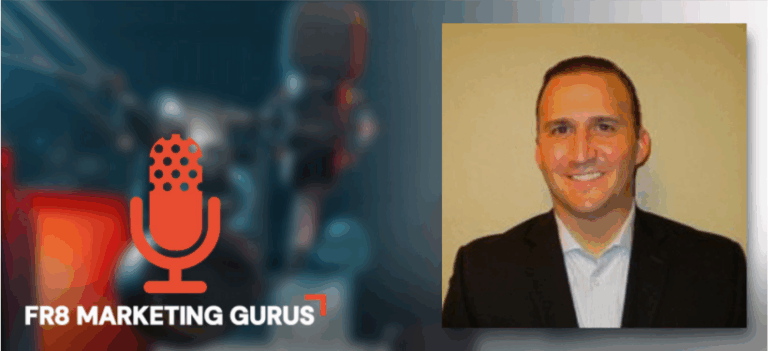The 2V-2R Formula: How Modern Sales Teams Are Breaking Through Digital Noise
The days of dropping off donuts at the front desk and calling it a "site visit" are over. Today's buyers have fundamentally changed how they evaluate vendors, and sales teams that haven't adapted are struggling to hit their numbers. Andy Hedrick, founder of Green Path Technology, discovered this shift the hard way—and his solution is helping companies achieve 15x to 35x returns on their sales investments.
After 29 years in logistics technology sales, including stints at major players like Trimble and TMW Systems, Hedrick recognized that the traditional sales playbook was failing. His response? The development of what he calls the "2V-2R ratio"—a framework that's transforming how companies approach modern sales and marketing alignment.

The Death of the Traditional Sales Model
“I was that person doing city blitzes all the time,” Hedrick admits. “You get an anchor meeting with somebody, then tell everybody you’re coming to town that week to stop by and give brochures and donuts and Panera Bread or whatever.” The problem? This approach was consuming massive amounts of time and resources while delivering diminishing returns.
The breaking point came during a typical sales trip to Seattle. After spending $1,500 to fly out for a meeting with a VP and CEO, Hedrick arrived only to be told the CEO had to travel unexpectedly. “I started getting frustrated, to be honest—too much time behind windshields, too much time going from hotel to hotel. I felt like I was wasting a lot of time.”
This frustration led to a crucial question: Could he generate demand digitally and still close deals at the same level? The answer would reshape his entire approach to sales.
The 2V-2R Framework: A New Sales Philosophy
The 2V-2R ratio stands for a simple but powerful concept: Value and Verified Results must be far greater than Risk and Resistors for the buyer. This framework applies from the top of the sales funnel all the way through closing.
“We do that with case studies, white papers, testimonials—value, value, value,” Hedrick explains. “And then what kind of introductory program can you do to get them a lot of value as well, prove yourself, and then expand.”
The approach focuses on three key areas that resonate with executive decision-makers:
- Revenue growth
- Hard operating cost reductions
- Streamlined operations
“If you can get that in front of decision makers, you’re going to close more business because they’re all about P&L,” Hedrick notes. “You’re talking their language.”
Why Executives Are the New Target
Unlike traditional sales approaches that often start with lower-level managers or dispatchers, Hedrick’s methodology targets executives directly. This isn’t just about reaching decision-makers—it’s about recognizing how the buyer journey has fundamentally changed.
“There’s a famous quote from Salesforce.com: 69% of executives feel like the buyer process has changed faster than they’ve adapted to it,” Hedrick shares. “Today, buyers will go to your website and your social media before they decide if they’re going to meet with you. That’s just the world we live in today.”
This shift has created an opportunity for companies willing to adapt. When executives step out from behind their company logos and speak directly into their communities, referrals can increase by 30%. The challenge is that many sales teams are still operating with outdated playbooks.
The Digital Transformation Results
When Hedrick decided to test his digital-first approach in 2018, the results were immediate and dramatic. “I 10x’d my own sales pipeline in the first six months,” he recalls. “These were big deals—$250,000, half-million-dollar deals.”
The approach proved particularly effective with high-level executives. “I thought at first, I don’t know if a CEO is going to engage with me online, but we tried it and they’re engaging more than with the other approach.”
The scalability advantages became clear quickly. Traditional in-person sales efforts might allow for dozens of touchpoints over months. Hedrick’s digital methodology enables 24,000 touches to 2,400 executives in six months—a scale impossible to achieve through traditional means.
Breaking the Feast-or-Famine Cycle
One of the most significant problems Hedrick observed in traditional sales operations was the feast-or-famine model. “They go out there and do a 10-email blitz, then they’re out selling, selling, selling, then they’re done,” he explains. “They’ll spend $100,000 on a campaign, ads, media, mailers, trade shows, and they actually get business. Then leadership says, ‘Okay guys, now your quota is 30% higher because we did this massive blitzkrieg on the market.'”
The solution is consistent pipeline feeding. “Always be feeding your funnel. Always be feeding your pipeline,” Hedrick emphasizes. His clients often report being “overwhelmed with deals” and asking him to reduce outreach—a good problem to have.
The Product-Market Fit Discovery Engine
Beyond just generating leads, Hedrick’s approach serves as a valuable market research tool. Companies can test new markets or validate product-market fit without the massive investment traditionally required.
“A lot of times we’re brought in where they think there’s a market over here, but they’re not sure, and they don’t want to spend $100,000 a month to figure it out,” Hedrick explains. “We’ll take 2,400 executive targets, hit them with 24,000 messages, and find out if there’s good product-market fit.”
This approach recently helped a client discover that their fuel hauling solution worked equally well for dairy operations—a $250,000+ market opportunity they hadn’t previously considered.
The Sales Team Evolution Challenge
The transformation isn’t just about technology and tactics—it’s about the type of salesperson needed in today’s market. Modern sales professionals need to be comfortable building relationships digitally, maintaining a professional social media presence, and engaging authentically online.
“The most successful people I’ve seen in terms of sales have engaging content on their social media,” Hedrick notes. “They’re at trade shows, they do personal posts occasionally, and they get testimonials from people they’ve worked with on LinkedIn.”
However, finding these modern sales professionals has become increasingly difficult. Many companies are looking for unicorns who can handle everything from prospecting to closing while maintaining digital relationships and managing complex CRM systems.
The Outsourcing Evolution
This challenge has led to an interesting evolution in Hedrick’s business model. Initially focused on lead generation and qualification, Green Path Technology now often provides full sales outsourcing services.
“We did a proposal not too long ago where the alternative would have been $43,000 a month, and our proposal was $9,500 a month plus commission,” Hedrick shares. “If I’m the CEO of a company and they’re giving me guarantees of inbound demand and deals, it’s a win-win scenario.”
This represents a significant shift in how companies think about sales operations. Just as marketing has been successfully outsourced for years, sales is becoming the next function companies are willing to delegate to specialists.
The Content Marketing Connection
Central to the 2V-2R approach is the recognition that sales and marketing must work together more closely than ever. Sales teams need content that demonstrates value and verified results, while marketing teams need feedback from actual sales conversations to refine their messaging.
“The most successful organizations have a good working relationship between marketing and sales,” Hedrick observes. “They’re all on the same sheet of music, and it works really well when that happens.”
This collaboration extends to personal branding as well. Sales professionals who actively share valuable content, engage authentically on social media, and leverage testimonials consistently outperform those who don’t.
Practical Implementation: The Podcast Strategy
One of Hedrick’s most creative tactics demonstrates the integration of relationship-building and content creation: podcasting with potential clients and partners.
“Let them talk about themselves,” he explains. “You’re giving them something of value. And what happens? They always ask, ‘What do you do, Andy?’ Well, we help companies with 15x to 35x return on their sales growth projects. And a majority of our clients we podcasted with first.”
This approach exemplifies the modern sales methodology: provide value first, build genuine relationships, and let business opportunities emerge naturally from authentic connections.
The Market Reality Check
Despite the success of digital approaches, Hedrick acknowledges that market conditions vary across different segments. While some areas like warehousing and 3PL operations continue growing strongly, others like international freight forwarding are in “wait and see” mode due to trade uncertainties.
His advice for companies facing slower growth? “You need to do more outreach, but not spend a lot more money doing it. Get in front of more of the right people with the right message.”
The Motivation Factor
One unexpected benefit of the modern approach is its impact on sales team motivation. “They’ve been doing a certain thing that hasn’t been working very well, and we come in and say, ‘What if we do these three things and get this in front of thousands of people?’ They’re like, ‘You mean I don’t have to jump in my car and go across town every other day and check off a box that says site visit?'”
The result is often renewed enthusiasm and better performance from sales teams who can focus on what they do best—building relationships and closing deals—rather than spending time on inefficient prospecting activities.
The Secret Sauce: What's In It For Them
When asked for his key advice, Hedrick doesn’t hesitate: “What’s in it for them? In your marketing material, your media, your LinkedIn profile, your social media, your proposals, your pitch decks, your website—if you make it about what’s in it for them, you’re going to see massively different results.”
This philosophy, inspired by motivational speaker Zig Ziglar’s famous quote—”You can have everything in life you want if you help enough other people get what they want”—represents a fundamental shift from self-focused to customer-focused communication.
Too many companies still lead with information about themselves: years in business, number of employees, company history. Modern buyers skip this entirely. They want to know immediately how you can help them grow revenue, reduce costs, or streamline operations.
Looking Forward: The Sales Profession's Future
As artificial intelligence and automation continue to reshape business operations, the human elements of sales become more valuable, not less. However, those human elements need to be deployed more strategically.
The successful sales professionals of tomorrow will be those who master the balance between digital efficiency and human connection. They’ll use technology to reach more prospects and deliver more value, but they’ll win deals through authentic relationships and demonstrated expertise.
Companies that embrace this evolution—like those implementing Hedrick’s 2V-2R framework—are seeing remarkable results. Those that continue dropping off donuts and hoping for the best will find themselves increasingly irrelevant in a market that rewards value, verified results, and genuine customer focus.
The transformation isn’t just about changing tactics—it’s about changing mindset. From interrupting prospects to providing value. From talking about yourself to focusing on their needs. From hoping for referrals to systematically earning them through demonstrated results.
In an era where everyone is trying to break through digital noise, the companies that succeed will be those that stop shouting and start solving problems. The 2V-2R formula provides a roadmap for making that transition—and the results speak for themselves.
FR8 Marketing Gurus
A podcast where freight, logistics, and supply chain leaders come to talk real marketing.


